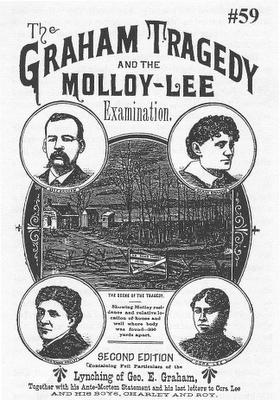
The Sarah Gorham Graham Case
Springfield, Missouri has a history of sensational true crime cases, but one of the oldest is the tale of Sarah Gorham Graham. Sarah was born in December of 1851, and little is known about her until her marriage to George Graham in Fort Wayne, Indiana in 1871. George spent most of the first years of their marriage in prison for crimes including horse theft and forgery. Though Sarah’s family urged her to divorce George, they had two sons by this time and she wanted to keep the family together. While imprisoned for forgery, George attended a meeting led by Emma Malloy, leader of the Women’s Christian Temperance Union. She had gained notoriety in the United States and Europe for her work with churches, where she would lead revivals and preach against alcohol.
After his sentence for forgery was complete, George found Emma Malloy and was given a job at the newspaper she published in Laporte, Indiana. Over the next few years, Sarah and her children followed George as he moved with Emma and her company all over the midwest. George became very friendly with Emma’s “adopted daughter”, Cora A. Lee. Although Emma never officially adopted Cora, she took her under her wing when Cora was a teenager and served a maternal role in her life for several years. Some report that George and Emma were “friendly” as well, and there are reports that George confessed to this.
Growing tired of the way she was treated by George, Sarah returned to Fort Wayne to be nearer to family as George continued on to Springfield with Emma and Cora. Not long after their arrival in 1885, the group set up a homestead southwest of Springfield on Brookline Road. In July of that year, George and Cora were married by a local Congregationalist member.
In September of the same year, Sarah had learned of this “marriage” and wanted to meet with George and Cora together. Some historians believe that she intended to convince the new couple that their marriage was a sham as she had never divorced George. She also brought her sons along, possibly in a ploy to show Cora that she was tearing their family apart. George met Sarah and their sons in St. Louis, and the four continued by train to Springfield. Shortly after her arrival, Sarah disappeared and George took the boys to the homestead outside of Springfield.
By Christmas of 1885, Sarah’s family in Indiana were worried, as they had not heard from her in months. When a few members of her family journeyed to Springfield and learned of George’s marriage to Cora, they contacted local police and a warrant was issued for his crime of bigamy. This charge, combined with those for bad checks he had used in the area, landed him in the Greene County Jail.
The mystery became a popular topic in newspapers around the country, as Emma Malloy was still a popular speaker on behalf of the Temperance Movement. In February of 1886, Sarah’s body was found in an abandoned well on the property of the homestead. George confessed to killing Sarah, but swore he acted alone. Police weren’t convinced by this, as his story didn’t line up with the facts. He said that he stabbed Sarah and dropped her into the well, but there was evidence of a gunshot wound and her body had been carefully lowered into the well, which would have taken at least two people. Emma and Cora were eventually arrested as accomplices to the murder.

Image used in articles about the shocking case, which was reported on around the world.
Court hearings began in March of 1886. The events were well attended by journalists and curious onlookers alike, and gathered national attention. The case was even reported in The New York Times. In April, a mob of over 100 masked men stormed Greene County Jail and took George. They brought him to the area that would later be Grant Beach Park, and hung him from a tree. After this, both Cora and Emma were acquitted or dismissed.
The rest of Cora’s life is unknown. It is believed she could have taken another name and moved elsewhere, hiding her past. Emma Malloy moved out west, living in California and Washington. After a bit of time out of the public eye, she began speaking publicly against alcohol again. She died in 1907.
George was buried in a plain, pine coffin in the “pauper’s corner” of Hazelwood Cemetery. There was no ceremony, and the grave is unmarked. Sarah’s final resting place, however, has a much more detailed story.
After learning that Sarah’s family in Indiana couldn’t afford to have her remains sent there for burial, generous Springfieldians chipped in to give her the burial she deserved. A nice coffin was provided, a horse-drawn hearse was reserved, and several arrangements of flowers were donated. The crowd of people attending her funeral overflowed from the Christ Episcopal Church on Kimbrough and Walnut, and Reverend William H. Osborn gave the eulogy. She was buried in Maple Park Cemetery in an unmarked grave, but local would bring flowers to place in remembrance.
Generations later, Cliff Gorham, a Minnesota native, learned that Sarah was his ancestor. After hearing about the way the community rallied to provide for Sarah’s burial and funeral, he was moved to tears. He purchased a tombstone from Wommack Monument Company. Cliff made sure to include “Buried here by the loving citizens of Springfield” on the granite marker.
Written by Meg Pearson, 2022.
Special thanks to Tiffany Mims, Superintendent of Maple Park Cemetery for information on this story.
Sarah H Gorham Graham. View Gravestone Photos from across Missouri. (n.d.). https://missourigravestones.org/view.php?id=771263
The Graham tragedy. Murder by Gaslight. (n.d.). http://www.murderbygaslight.com/2011/04/graham-tragedy.html